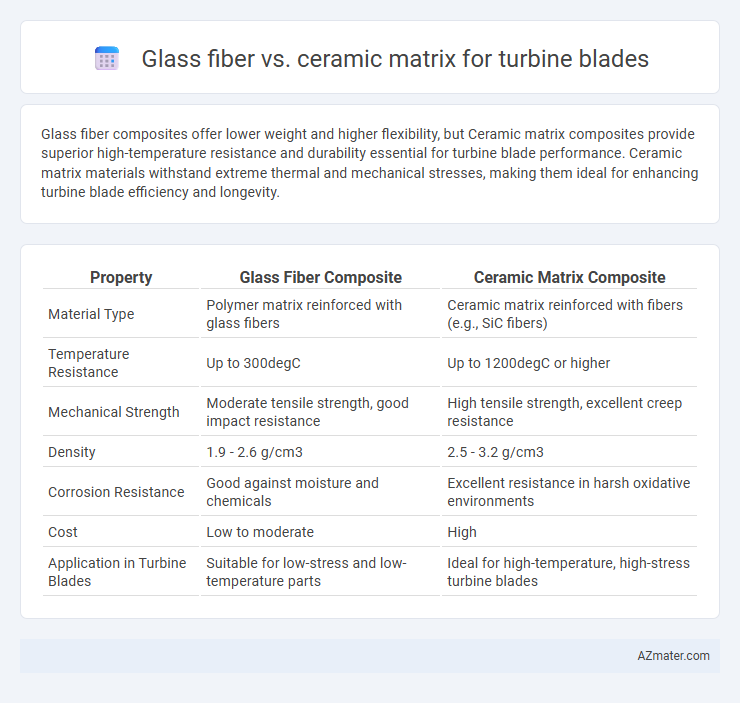Glass fiber composites offer lower weight and higher flexibility, but Ceramic matrix composites provide superior high-temperature resistance and durability essential for turbine blade performance. Ceramic matrix materials withstand extreme thermal and mechanical stresses, making them ideal for enhancing turbine blade efficiency and longevity.
Table of Comparison
| Property | Glass Fiber Composite | Ceramic Matrix Composite |
|---|---|---|
| Material Type | Polymer matrix reinforced with glass fibers | Ceramic matrix reinforced with fibers (e.g., SiC fibers) |
| Temperature Resistance | Up to 300degC | Up to 1200degC or higher |
| Mechanical Strength | Moderate tensile strength, good impact resistance | High tensile strength, excellent creep resistance |
| Density | 1.9 - 2.6 g/cm3 | 2.5 - 3.2 g/cm3 |
| Corrosion Resistance | Good against moisture and chemicals | Excellent resistance in harsh oxidative environments |
| Cost | Low to moderate | High |
| Application in Turbine Blades | Suitable for low-stress and low-temperature parts | Ideal for high-temperature, high-stress turbine blades |
Introduction to Turbine Blade Materials
Turbine blade materials must exhibit exceptional thermal resistance, mechanical strength, and durability under extreme operating conditions. Glass fiber composites offer lightweight properties and good corrosion resistance but lack the high-temperature stability required for advanced turbine applications. Ceramic matrix composites (CMCs) provide superior heat tolerance and structural integrity at elevated temperatures, making them more suitable for high-performance turbine blades in gas turbine engines.
Overview of Glass Fiber Composites
Glass fiber composites for turbine blades offer high strength-to-weight ratios and excellent fatigue resistance, making them suitable for lightweight structural applications. These composites consist of glass fibers embedded in a polymer matrix, providing good corrosion resistance and cost-effectiveness compared to ceramic matrix composites. However, glass fiber composites have lower temperature tolerance and thermal stability, limiting their use in high-temperature turbine environments where ceramic matrix composites excel.
Overview of Ceramic Matrix Composites
Ceramic matrix composites (CMCs) offer superior high-temperature resistance, lower density, and enhanced oxidation resistance compared to glass fiber composites, making them ideal for turbine blade applications in extreme environments. Unlike glass fiber, CMCs combine ceramic fibers such as silicon carbide with a ceramic matrix to improve fracture toughness and thermal stability at temperatures exceeding 1300degC. This advanced material enables turbine blades to operate more efficiently with reduced cooling requirements and longer service life in jet engines and industrial gas turbines.
Mechanical Strength Comparison
Ceramic matrix composites (CMCs) exhibit significantly higher mechanical strength and temperature resistance than glass fiber composites, making them more suitable for turbine blade applications exposed to extreme thermal and mechanical stresses. Glass fiber composites, while offering good tensile strength and lightweight properties, lack the high-temperature stability and fracture toughness inherent to ceramic matrices. The superior creep resistance and fatigue performance of ceramic matrix materials ensure enhanced durability and reliability in high-performance turbine blades.
Thermal Resistance and Stability
Ceramic matrix composites (CMCs) exhibit superior thermal resistance and stability compared to glass fiber composites, enabling turbine blades to withstand temperatures above 1200degC without significant degradation. Glass fiber materials typically degrade at lower temperatures, around 600-800degC, limiting their application in high-temperature turbine environments. The enhanced crystalline structure and bonding in ceramic matrices provide greater resistance to thermal shock and oxidation, crucial for maintaining structural integrity in advanced turbine blades.
Weight and Density Considerations
Glass fiber composites exhibit significantly lower density, typically around 2.5 g/cm3, making them advantageous for applications demanding weight reduction in turbine blades. Ceramic matrix composites, with densities ranging from 3.0 to 3.5 g/cm3, provide superior high-temperature stability but contribute to increased weight compared to glass fiber alternatives. Balancing turbine blade performance requires careful evaluation of density-related trade-offs alongside mechanical and thermal properties.
Durability and Fatigue Performance
Ceramic matrix composites (CMCs) exhibit superior durability and fatigue resistance compared to glass fiber composites when used in turbine blades, thanks to their high-temperature stability and resistance to oxidation and thermal fatigue. Glass fiber composites, while lightweight and cost-effective, tend to degrade faster under cyclic thermal and mechanical loads, limiting their service life in harsh turbine environments. The advanced microstructure of CMCs enables sustained performance under extreme stress and temperature fluctuations, making them the preferred choice for next-generation turbine blade applications.
Manufacturing Processes and Complexity
Glass fiber turbine blades rely on composite manufacturing techniques such as filament winding or resin transfer molding, offering lower processing temperatures and simpler cure cycles compared to ceramic matrix composites. Ceramic matrix turbine blades require advanced processes like chemical vapor infiltration or hot pressing to achieve high-temperature resistance, resulting in more complex and time-intensive fabrication steps. The intricate handling of brittle ceramics and precise thermal treatments greatly increase manufacturing complexity and costs relative to glass fiber composites.
Cost Analysis and Economic Viability
Glass fiber composites offer a significantly lower material and manufacturing cost compared to ceramic matrix composites (CMCs) for turbine blades, making them economically attractive for applications with moderate temperature requirements. Ceramic matrix composites, while expensive due to complex fabrication and raw material costs, provide superior high-temperature resistance and durability, reducing maintenance and replacement expenses in high-performance turbine environments. The overall cost analysis reveals that glass fiber is cost-effective for low to mid-range turbines, whereas ceramic matrix composites justify their higher initial investment through enhanced lifecycle performance and fuel efficiency in advanced aerospace and industrial gas turbines.
Future Trends in Turbine Blade Materials
Future trends in turbine blade materials emphasize enhancing performance with ceramic matrix composites (CMCs) due to their superior thermal stability and lightweight properties compared to traditional glass fiber composites. Advances in CMC manufacturing enable higher operating temperatures and improved oxidation resistance, leading to increased engine efficiency and reduced cooling requirements. Ongoing research targets optimizing fiber orientation and matrix compositions to further extend blade lifespan and reliability under extreme turbine conditions.

Infographic: Glass fiber vs Ceramic matrix for Turbine blade
 azmater.com
azmater.com